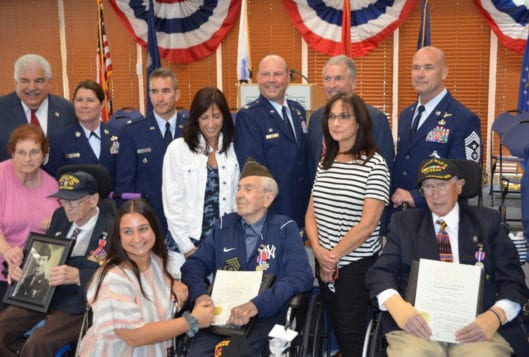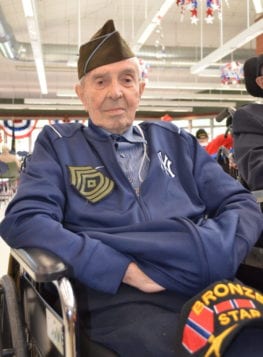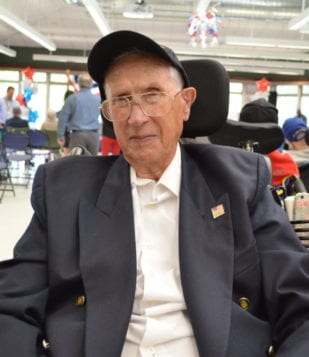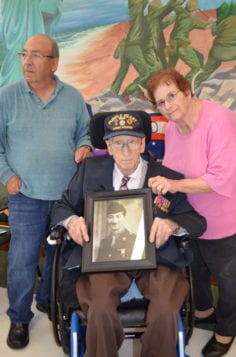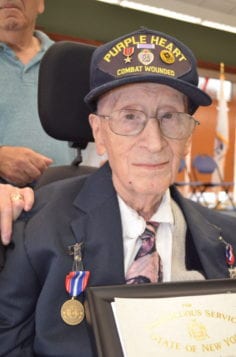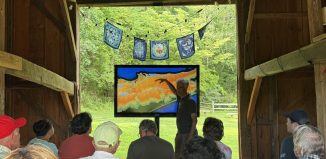By Donna Deedy
Few D-Day veterans are alive today, but you can find three of them at Long Island State Veterans Home at Stony Brook University, where an award ceremony was held June 6 in honor of the 75th anniversary of D-Day and Operation Overlord, the largest amphibious operation in military history.
One hundred World War II veterans were presented with the Governor’s Proclamation for the occasion, while Phillip DiMarco and Frank DePergola were decorated with the New York State Conspicuous Service Cross and Charles Cino was decorated with the New York State Medal for Merit. All three men participated in the Normandy invasion.
Ninety-seven-year-old DiMarco was among the first wave of soldiers to storm the beach. “I’m just grateful to have survived,” he said.
Two-thirds of his fellow troopers perished in the first 30 minutes of battle, according to information provided by the state. DiMarco’s group suffered from wounds, hunger, exhaustion and trench foot and survived on green apples and stagnant water doped with halazone tablets, a chlorine-based water purifier.
“Our World War II heroes and heroines who came of age during the Great Depression, gave new meaning to the words, duty, service, sacrifice, courage and honor,” said Fred Sganga, executive director of the veterans home. “They answered the call to save the world from the two most powerful and ruthless military machines ever assembled, instruments of conquest in the hands of fascist maniacs.”
War veterans often are understandably reluctant to talk about their horrific war experiences — it’s clearly too painful to relive. At their advanced ages, speaking also requires tremendous effort. Their stories live on through oral history and past memorials. But these men have stories to share from which history can be garnered. After 75 years, their summaries of what happened are often succinct and to the point.
“There was this man who didn’t like Jews, and we got him,” 96-year-old DePergola said. DePergola was part of D-Day plus 10, meaning his troop arrived 10 days after the initial invasion. He was one of only four people to survive the war out of a platoon of 20, his daughter Jean Pulizzi said.
In his campaign in Germany and Poland, DePergola encountered what they thought were abandoned buildings, only to discover upon entering about 30 captives: Jews, Catholics and Muslims. It was essentially a concentration camp. The stench inside, he said, was intense and unforgettable. The people, he said, were emaciated and wore black and white striped uniforms.
“They were glad to see us,” DePergola said.
While on assignment from headquarters to retrieve maps, DePergola encountered two German soldiers in the woods in Metz, France. He took them captive with a German Luger pistol he had taken off another German officer earlier, since he forgot his issued rifle at headquarters, and returned to base with the captive soldiers. For this, he was awarded a Bronze Star, a military badge of heroism.
For Thursday’s ceremony, DePergola insisted on wearing his favorite cap, which bears the Purple Heart badge, an emblem that recognizes war injuries. DePergola was shot in the knee during battle, but back then, he said, you remained on active duty.
Cino was 18 years old when he stormed the Normandy beaches. He was responsible for transporting under the cover of darkness thousands of troops in a landing ship tank, or LST, an amphibious boat capable of landing on shore carrying tanks, cargo and troops. Cino, when he heard it was the 75th anniversary of D-Day nodded, shrugged his shoulders and shook his head. He could utter only one full sentence, “I was there.” Then he closed his eyes.
Both DePergola and DiMarco, in addition to their experience at Normandy, fought in the Battle of the Bulge, the last major German offensive of World War II during the harsh winter in 1945.
The D-Day ceremony included color guards and live musicians, who sang patriotic tunes and played the bugle. About half of the veterans in attendance were in wheelchairs, and despite their limitations, tapped their toes to the music. Many were able to salute the flag. Some veterans wiped tears from their eyes, particularly when the room sang the lyrics to “God Bless America.”
During World War II, 900,000 New Yorkers went to the battlefield; 43,000 did not come home.
The nation’s largest population of World War II vets live at Long Island State Veterans Home
All photos by Donna Deedy

